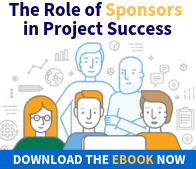If you are a Next Generation Change Agent, you know what your #1 priority is. It’s not about spending precious time filling out templates and checklists. It’s not about a useless effort trying to eliminate (instead of manage) resistance. And it’s not about communication messages that try to convince Targets that this change will be good for them. For a Next Generation Change Agent, that’s missing the boat! 
The fact is, having visible and active Sponsors at all levels who demonstrate their commitment to a change, both publicly and privately, is the most important factor in a fast and successful implementation {Tweet This}. So instead of spending all their time looking down the organization at the Targets, NextGen Change Agents spend the majority of their time looking up, working with their Sponsors to ensure they are actively Expressing, Modeling, and Reinforcing their commitment to the change.
Who is a Sponsor?
In the AIM Change Management Methodology, developer Don Harrison defines 4 crucial implementation roles as the CAST of Characters. Sponsors are defined as those who authorize, legitimize and/or demonstrate ownership for the change (Authorizing Sponsors) or reinforce the change at the local level (Reinforcing Sponsors).
Sponsorship, however, is not a voluntary position. A manager cannot choose whether or not to Sponsor a project. Leaders are automatically Sponsors if they have anyone reporting to them who will be impacted by the change. That’s the position part. But Sponsorship is both position and action!
The Three Actions Needed by Every Sponsor
Sponsors must do more than just make sure the project gets launched, or authorize funding for an initiative. There are, in fact, three very specific actions that all Sponsors must demonstrate on a daily basis to show their personal commitment to a change. They must:
- Express commitment to the change by what they say
- Model commitment to the new behaviors by what they do
- Reinforce the new behaviors by applying rewards and consequences within their chain of command
Equally important, there must be alignment in what Sponsors Express, Model, and Reinforce. However, reinforcement is the real power lever for driving change faster and more successfully. AIM builds a mathematical model around Sponsorship: 
- 10% of project success depends on what leaders say
- 20-30% depends on what leaders model
- 50-60% depends on what leaders reinforce
Remember the speed of change “out there” depends on Sponsor drive; it’s the actions of Sponsors that drive the pace of an implementation. And we are not just talking about the actions of one individual…we are talking about the cascade of leadership, level by management level, down and across the organization.
Best Practice Tips to Ensure Sponsors Do What’s Needed
All too often, Sponsors view their role as more of a figurehead/passive voice, instead of being accountable for results. How do you get them to do what is needed? First educate your Sponsors on their roles and responsibilities. Many Sponsors are unaware of the 3 best practice behaviors that good Sponsors must consistently demonstrate. Then contract with individual Sponsors for what you specifically need from them at a particular point in time in the project. Here are a few best practice tips:
- Treat Managers as Targets First. Change Agents should not assume Managers are aligned with the change simply by virtue of their organizational position. In fact, you will not get Managers to behave like Sponsors until they know what’s in it for them on this change, and what this change means to them personally.
- Remember to View the Project from the Sponsor’s Frame of Reference. Truth be told, most Sponsors don’t care that much about “change management.” What they do care about is getting things done faster, cheaper, and at a higher level of quality. When you are speaking to your Sponsor, it’s critical to make the conversation about business outcomes, not change management.
- Work to Build Trust and Credibility, or Select Agents with the Right Relationships Already. Managers need to be able to trust an Agent before they will work with them. Trust is built when Change Agents do what they say they are going to do, and when they put Sponsors in a position for them to look and be successful.
- Make Certain There are Appropriate Reinforcements for Mid and Upper-Level Managers. Managers are just like everyone else-- they do something because they are reinforced for it in some way. That’s why reinforcements are needed to get these managers to "Express, Model, and Reinforce" their demonstrated commitment to the change. If the change is transformational, these reinforcements must be “implementation-specific.”
Project success depends on the demonstrated Expressed, Modeled, and Reinforced commitment of all the Managers and Leaders with direct reports that are impacted in some way by the change. This cascade of behavioral commitment is the single most important factor in the speed of implementation for a change project, and should be a Change Agent’s #1 priority.


